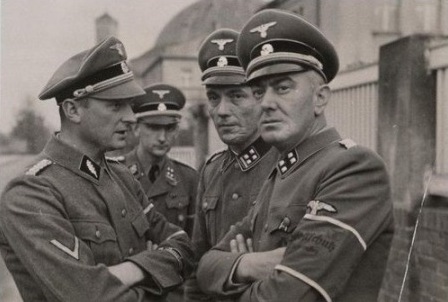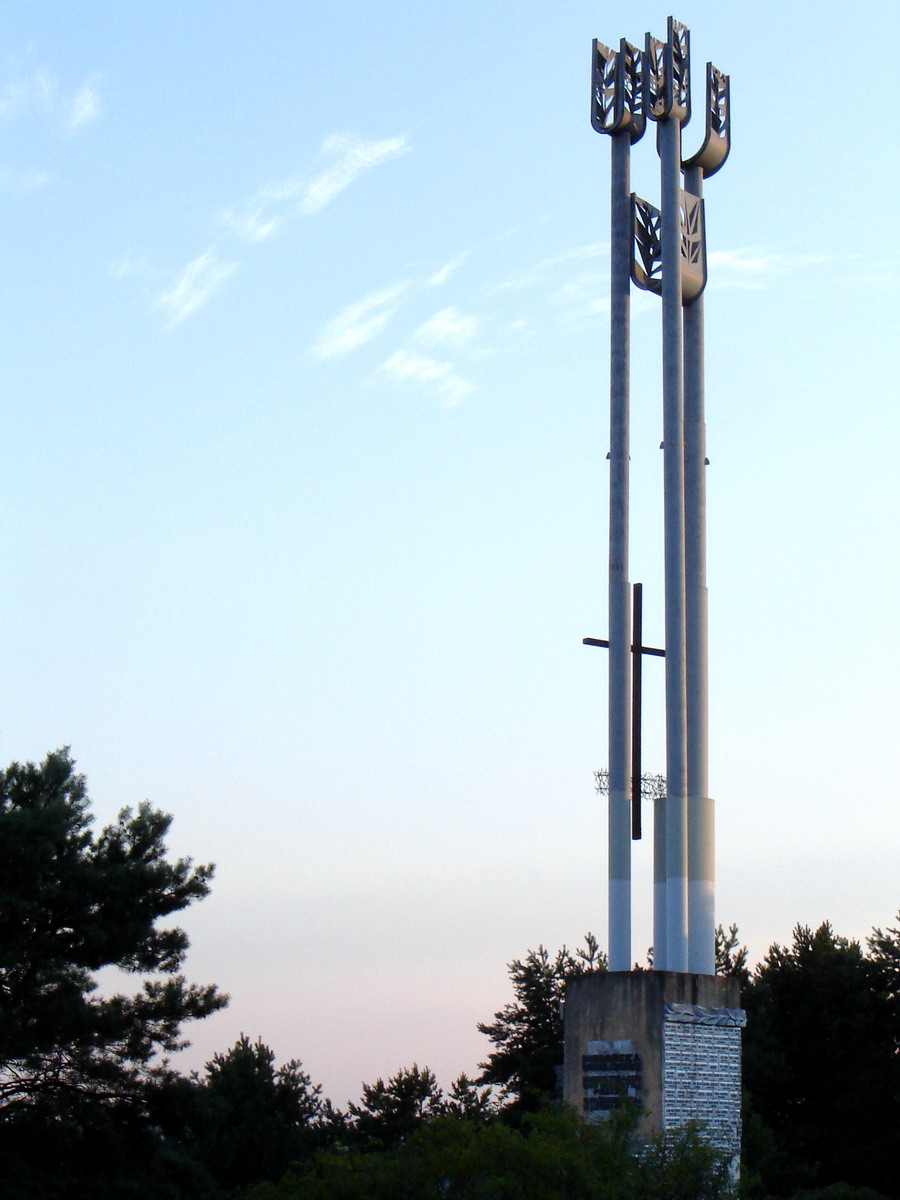Valley of Death (Bydgoszcz) on:
[Wikipedia]
[Google]
[Amazon]
 Valley of Death ( pl, Dolina Śmierci) in Fordon, Bydgoszcz, northern
Valley of Death ( pl, Dolina Śmierci) in Fordon, Bydgoszcz, northern
Intelligenzaktion. September–November 1939.
Kampania Wrześniowa 1939.pl (2006). Retrieved 2 November 2015. The murders were a part of Intelligenzaktion in Pomerania, a
Das dritte Reich und die Juden
', C.H. Beck, Munich 2006, .
 Victims, mainly Polish intelligentsia:
Victims, mainly Polish intelligentsia:
Einsatzgruppen in Polen
' Warsaw: Bellona, 2009. , pp. 44-45. Between September 1939 and April 1940 Selbstschutz - together with other Nazi-German formations - murdered tens of thousands of Poles in Pomerania. Established investigations point to
* Anti-Polonism *
 Valley of Death ( pl, Dolina Śmierci) in Fordon, Bydgoszcz, northern
Valley of Death ( pl, Dolina Śmierci) in Fordon, Bydgoszcz, northern Poland
Poland, officially the Republic of Poland, is a country in Central Europe. It is divided into 16 administrative provinces called voivodeships, covering an area of . Poland has a population of over 38 million and is the fifth-most populou ...
, is a site of Nazi German
Nazi Germany (lit. "National Socialist State"), ' (lit. "Nazi State") for short; also ' (lit. "National Socialist Germany") (officially known as the German Reich from 1933 until 1943, and the Greater German Reich from 1943 to 1945) was ...
mass murder committed at the beginning of World War II
World War II or the Second World War, often abbreviated as WWII or WW2, was a world war that lasted from 1939 to 1945. It involved the vast majority of the world's countries—including all of the great powers—forming two opposing ...
and a mass grave
A mass grave is a grave containing multiple human corpses, which may or may not be identified prior to burial. The United Nations has defined a criminal mass grave as a burial site containing three or more victims of execution, although an exact ...
of 1,200–1,400 Poles
Poles,, ; singular masculine: ''Polak'', singular feminine: ''Polka'' or Polish people, are a West Slavic nation and ethnic group, who share a common history, culture, the Polish language and are identified with the country of Poland in C ...
and Jews
Jews ( he, יְהוּדִים, , ) or Jewish people are an ethnoreligious group and nation originating from the Israelites Israelite origins and kingdom: "The first act in the long drama of Jewish history is the age of the Israelites""The ...
murdered in October and November 1939 by the local German ''Selbstschutz
''Selbstschutz'' (German for "self-protection") is the name given to different iterations of ethnic-German self-protection units formed both after the First World War and in the lead-up to the Second World War.
The first incarnation of the ''Selb ...
'' and the Gestapo
The (), abbreviated Gestapo (; ), was the official secret police of Nazi Germany and in German-occupied Europe.
The force was created by Hermann Göring in 1933 by combining the various political police agencies of Prussia into one orga ...
.Encyklopedia PWNIntelligenzaktion. September–November 1939.
Kampania Wrześniowa 1939.pl (2006). Retrieved 2 November 2015. The murders were a part of Intelligenzaktion in Pomerania, a
Nazi
Nazism ( ; german: Nazismus), the common name in English for National Socialism (german: Nationalsozialismus, ), is the far-right totalitarian political ideology and practices associated with Adolf Hitler and the Nazi Party (NSDAP) in ...
action aimed at the elimination of the Polish intelligentsia
The intelligentsia is a status class composed of the university-educated people of a society who engage in the complex mental labours by which they critique, shape, and lead in the politics, policies, and culture of their society; as such, the i ...
in Reichsgau Danzig-West Prussia
Reichsgau Danzig-West Prussia (german: Reichsgau Danzig-Westpreußen) was an administrative division of Nazi Germany created on 8 October 1939 from annexed territory of the Free City of Danzig, the Greater Pomeranian Voivodship (Polish Corridor ...
, which included the former Pomeranian Voivodeship ("Polish Corridor
The Polish Corridor (german: Polnischer Korridor; pl, Pomorze, Polski Korytarz), also known as the Danzig Corridor, Corridor to the Sea or Gdańsk Corridor, was a territory located in the region of Pomerelia (Pomeranian Voivodeship, easter ...
"). It was part of a larger genocidal
Genocide is the intentional destruction of a people—usually defined as an ethnic, national, racial, or religious group—in whole or in part. Raphael Lemkin coined the term in 1944, combining the Greek word (, "race, people") with the Latin ...
action that took place in all German occupied Poland
German(s) may refer to:
* Germany (of or related to)
** Germania (historical use)
* Germans, citizens of Germany, people of German ancestry, or native speakers of the German language
** For citizens of Germany, see also German nationality law
**Ge ...
, code-named Operation Tannenberg
Operation Tannenberg (german: Unternehmen Tannenberg) was a codename for one of the anti-Polish extermination actions by Nazi Germany that were directed at the Poles during the opening stages of World War II in Europe, as part of the ''Generalplan ...
.Saul Friedländer
Saul Friedländer (; born October 11, 1932) is a Czech-Jewish-born historian and a professor emeritus of history at UCLA.
Biography
Saul Friedländer was born in Prague to a family of German-speaking Jews. He was raised in France and lived thro ...
, Das dritte Reich und die Juden
', C.H. Beck, Munich 2006, .
History
 Victims, mainly Polish intelligentsia:
Victims, mainly Polish intelligentsia: teacher
A teacher, also called a schoolteacher or formally an educator, is a person who helps students to acquire knowledge, competence, or virtue, via the practice of teaching.
''Informally'' the role of teacher may be taken on by anyone (e.g. whe ...
s, priest
A priest is a religious leader authorized to perform the sacred rituals of a religion, especially as a mediatory agent between humans and one or more deities. They also have the authority or power to administer religious rites; in partic ...
s, office worker
A white-collar worker is a person who performs professional, desk, managerial, or administrative work. White-collar work may be performed in an office or other administrative setting. White-collar workers include job paths related to government, ...
s, were listed on so called ''Sonderfahndungsbuch Polen
''Special Prosecution Book-Poland'' (german: Sonderfahndungsbuch Polen, pl, Specjalna księga Polaków ściganych listem gończym) was the proscription list prepared by the Germans immediately before the onset of war, that identified more than 61, ...
'' (a list of people destined to be executed, made by Third Reich
Nazi Germany (lit. "National Socialist State"), ' (lit. "Nazi State") for short; also ' (lit. "National Socialist Germany") (officially known as the German Reich from 1933 until 1943, and the Greater German Reich from 1943 to 1945) was ...
officials before World War II
World War II or the Second World War, often abbreviated as WWII or WW2, was a world war that lasted from 1939 to 1945. It involved the vast majority of the world's countries—including all of the great powers—forming two opposing ...
) and another list made by Gestapo during the war.
The perpetrators were mainly from the new ''Selbstschutz
''Selbstschutz'' (German for "self-protection") is the name given to different iterations of ethnic-German self-protection units formed both after the First World War and in the lead-up to the Second World War.
The first incarnation of the ''Selb ...
'' battalions called the ''Volksdeutscher Selbstschutz
The ''Volksdeutscher Selbstschutz'' was an ethnic German self-protection militia, a paramilitary organization consisting of ethnic German (''Volksdeutsche'') mobilized from among the German minority in Poland. The ''Volksdeutscher Selbstschut ...
'', a paramilitary formation of civilian shooters composed of men from the German minority of pre-war Poland, as well as the ''Einsatzkommando'' 16 of ''SS Einsatzgruppen'' under command of ''SS-Sturmbannführer
__NOTOC__
''Sturmbannführer'' (; ) was a Nazi Party paramilitary rank equivalent to major that was used in several Nazi organizations, such as the SA, SS, and the NSFK. The rank originated from German shock troop units of the First World War ...
'' dr Rudolf Tröger.Jochen Böhler
Jochen Böhler (born 1969 in Rheinfelden) is a German historian, specializing in the history of Eastern Europe in the 19th and 20th century, especially the World Wars, the Holocaust, nationality and borderland studies. He is the recipient of sev ...
, Klaus-Michael Mallmann
Klaus-Michael Mallmann (born 3 November 1948, in Kaiserslautern) is a German historian at the University of Stuttgart.
Scientific career
Mallmann studied history, Sociology, Politics and German studies at the Saarland University. In 1979 he was a ...
, Jürgen Matthäus
Jürgen Matthäus (born 1959) is a German historian and head of the research department of the United States Holocaust Memorial Museum. He is an author and editor of multiple works on the history of World War II and the Holocaust. Matthäus was ...
: Einsatzgruppen in Polen
' Warsaw: Bellona, 2009. , pp. 44-45. Between September 1939 and April 1940 Selbstschutz - together with other Nazi-German formations - murdered tens of thousands of Poles in Pomerania. Established investigations point to
Ludolf von Alvensleben
Ludolf-Hermann Emmanuel Georg Kurt Werner von Alvensleben (17 March 1901 – 1 April 1970) was an SS functionary of Nazi Germany. He held positions of SS and Police Leader in occupied Poland and the Soviet Union, and was indicted for war crim ...
and Jakub Löllgen, as the main organizers of the mass murder. Other Germans involved in the crime were: ''Sturmbannführer
__NOTOC__
''Sturmbannführer'' (; ) was a Nazi Party paramilitary rank equivalent to major that was used in several Nazi organizations, such as the SA, SS, and the NSFK. The rank originated from German shock troop units of the First World War ...
s'' Erich Spaarmann, Meier, Schnugg, ''SS-Sturmbannführer
__NOTOC__
''Sturmbannführer'' (; ) was a Nazi Party paramilitary rank equivalent to major that was used in several Nazi organizations, such as the SA, SS, and the NSFK. The rank originated from German shock troop units of the First World War ...
'' dr Rudolf Tröger, '' SS man'' Baks, and a number of ''Volksdeutsche
In Nazi German terminology, ''Volksdeutsche'' () were "people whose language and culture had German origins but who did not hold German citizenship". The term is the nominalised plural of '' volksdeutsch'', with ''Volksdeutsche'' denoting a sin ...
'' including Wilhelm Neumann, Herbert Beitsch, Otto Erlichmann (Nazi
Nazism ( ; german: Nazismus), the common name in English for National Socialism (german: Nationalsozialismus, ), is the far-right totalitarian political ideology and practices associated with Adolf Hitler and the Nazi Party (NSDAP) in ...
mayor
In many countries, a mayor is the highest-ranking official in a municipal government such as that of a city or a town. Worldwide, there is a wide variance in local laws and customs regarding the powers and responsibilities of a mayor as well ...
of Fordon), and Walter Gassmann.
Other Nazi German mass murder sites in Bydgoszcz area are the villages of Tryszczyn
Tryszczyn is a village in the administrative district of Gmina Koronowo, within Bydgoszcz County, Kuyavian-Pomeranian Voivodeship, in north-central Poland. It lies south of Koronowo and north-west of Bydgoszcz. It is located in the historic reg ...
and Borówno.
See also
* Anti-Polonism *
List of Polish Martyrdom sites
Around six million Polish citizensProject in PosterumRetrieved 20 September 2013.History of Fordon 1939-1945
Extermination of Polish intelligentsia on Pomerania
Valley of Death - pictures and short description
Extermination of Polish intelligentsia on Pomerania
Valley of Death - pictures and short description
Bibliography
*Jochen Böhler, Klaus-Michael Mallmann, Jürgen Matthäus: Einsatzgruppen in Polen. Warszawa: Bellona, 2009. * {{DEFAULTSORT:Valley Of Death 1939 in Poland Einsatzgruppen Massacres in Poland Valleys of Poland Nazi war crimes in Poland Holocaust massacres and pogroms in Poland Mass murder in 1939 Reichsgau Danzig-West Prussia Bydgoszcz